26 January 2024
Weekly Market View
Time to rebalance
US stocks have broken to new record highs this week. The drivers of this rally, which we anticipated in our Outlook 2024 publication, are strong economic data, US Q4 earnings beats and robust global semiconductor demand.
However, our indicator of investor diversity is signalling a high risk of reversal in key equity markets. Given this, we believe it would be prudent for investors to trim their equity exposure.
In a portfolio context, while our foundation allocations remain unchanged and we remain Overweight on equities, this would mean reducing any excessive exposure to equities to bring them back to the target allocations based on one’s risk appetite.
We see a chance to average into safe havens such as US and European government bonds, where yields have turned more attractive after this year’s rebound. US short-duration inflation-protected bonds also look attractive as a hedge against the risk of any revival of inflation.
What is the implication of China’s latest policy easing on local equity and bond markets?
Are tensions on the Red Sea a risk to US inflation?
What are your latest three-month currency views?
Charts of the week: Too upbeat versus too downbeat?
US equities are at risk of a near-term reversal amid narrow investor diversity; China equities appear to be bottoming out
S&P500, S&P500 equal-weighted and Russell 2000* indices
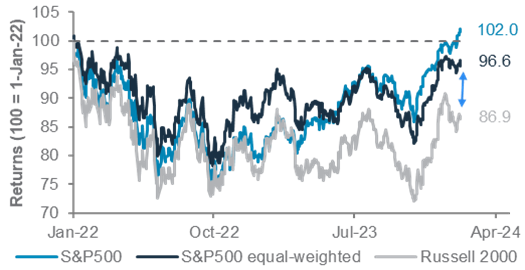
Hang Seng index, with key technical support and resistance

Source: Bloomberg, Standard Chartered; *represents US small cap stocks
Editorial
Time to rebalance
US stocks have broken to new record highs this week. The drivers of this rally, which we anticipated in our Outlook 2024 publication, are strong economic data, US Q4 earnings beats and robust global semiconductor demand. However, our indicator of investor diversity is signalling a high risk of reversal in key equity markets. Given this, we believe it would be prudent for investors to trim their equity exposure. In a portfolio context, while our foundation allocations remain unchanged and we remain Overweight on equities, this would mean reducing any excessive exposure to equities to bring them back to the target allocations based on one’s risk appetite. We see a chance to average into safe havens such as US and European government bonds, where yields have turned more attractive.
Strong earnings, economic data: The S&P500 index broke out of a major technical resistance, the record high of 2022. The key drivers: a) more than 80% of the S&P500 companies that have reported so far have beaten Q4 earnings estimates (upcoming technology sector earnings and their guidance for 2024 are likely crucial for the equity rally to sustain); b) stronger-than-expected business confidence data (PMIs) for January, which suggested manufacturing is seeing a recovery from last year’s recession and the services sector remains healthy (except for the Euro area); c) stronger-than-expected US GDP growth in Q4 2023; and d) strong forward guidance from TSMC, Taiwan’s leading global supplier of semiconductors.
Crowded investor positioning: However, our investor diversity indicators (fractals) are flagging two-out-three chance of a reversal in Global, US, Europe, EM ex-Asia and India equities and DM High Yield bonds. Within equity sectors, the indicators are flagging high risk of a reversal in technology, communication services, financial, industrial and real estate sectors in both the US and Europe and the consumer discretionary sector in the US. Investor positioning also looks stretched across most of these markets.
Investment implications: The high risk of a near-term pullback makes it prudent for investors who are fully invested to trim exposure. Of course, this does not mean getting out of equities altogether. We remain constructive on risk assets, especially with central banks poised to ease policy if growth and inflation continue their downtrend (as we heard from the ECB this week and are likely to hear from the Fed next week). In a portfolio context, though, those overexposed to equities and HY bonds compared with their risk tolerance could use this opportunity to rebalance their allocations. Those who are still building allocations to equities and HY bonds can wait for and use any pullback to add exposure. The S&P500 index has near-term technical support at 4,740, followed by 4,550 and 4,400.
Hedging potential headwinds: Besides crowded positioning, we believe caution is warranted due to the following: a) robust US earnings estimates (11% y/y estimated for 2024, including 16% y/y for technology sector) leave little room for downside surprises; b) deteriorating underlying indicators of job markets, such as the rate of hiring, quits and permanent job losses (next week’s US jobs data in focus); c) recent escalation of conflicts on the Red Sea, if sustained, could lead to a revival in global inflation, denting the economic soft-landing narrative and delaying policy rate cuts (page 6). We believe US short-duration inflation-protected government bonds, gold and energy sector equities are attractive hedges against any revival of inflation.
Upturn in China: China equities are likely to see a near-term bounce on the back of the new support measures (see page 4), but a sustained rally will need a more coordinated fiscal and monetary policy easing and a revival of business and consumer confidence. The Hang Seng index has strong technical support, having set a double-bottom pattern over the past year (14,794 and 14,597). However, the upside could be limited to 18,300 in the absence of large-scale and coordinated stimulus measures.
Bullish on EUR and JPY: In FX, we remain bullish on the EUR and JPY over a 3-month horizon. (see page 5).
The weekly macro balance sheet
Our weekly net assessment: On balance, we see the past week’s data and policy as neutral for risk assets in the near term
(+) factor: Supportive China policies, improving business confidence
(-) factor: Geopolitical tensions, deteriorating Euro area data
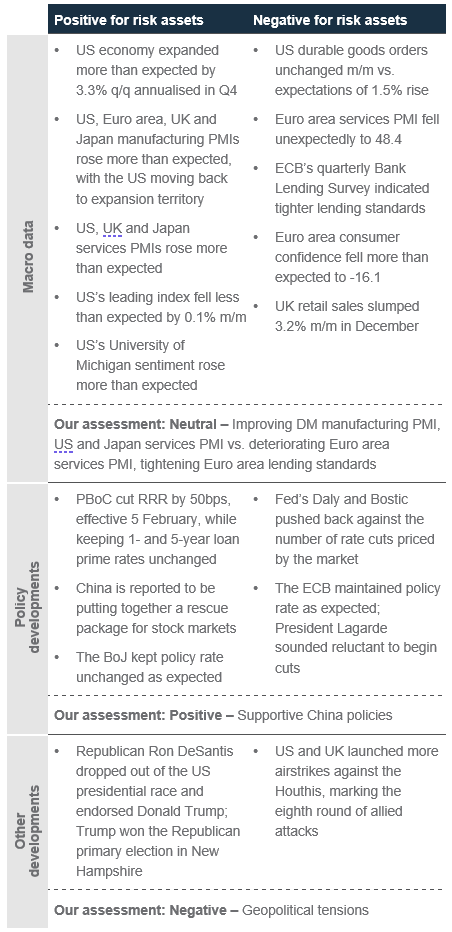
Manufacturing sector business confidence continued to recover in the US and Europe, with the US returning to expansion territory
Manufacturing sector PMIs across major economies

Services sector business confidence remained resilient across Developed Markets, except for the Euro area
Services sector PMIs across major economies
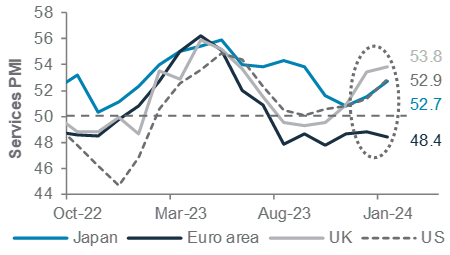
China cut bank reserve requirements by 50bps to boost liquidity ahead of the Lunar New Year holidays, among other steps to support growth
China reserve requirement ratio for various banks

Top client questions
What is the implication of China’s latest policy easing on local equity and bond markets?
China announced several supportive policy measures recently. The PBoC’s 50bps reserve requirement ratio (RRR) cut was the largest since December 2021. According to PBoC Governor Pan, monetary policy is expected to remain loose. In parallel, more relaxation measures were announced in China’s property sector, including expanding the use of commercial property-pledged loans, joint policies between China and HK regulators to intensify cross-border fund flows and opening onshore repurchase market for foreign investors. In the pipeline, Bloomberg reported that Chinese authorities are studying the launch of a CNY2trn stabilisation fund using the offshore funds of state-owned enterprises.
In our view, these measures should improve investor confidence and support both China and Hong Kong equity markets, at least in the short term. Valuations remain depressed (the MSCI China index is trading 1.2 standard deviations below its historical valuation average), and investor positioning is light – both likely to make the market more sensitive to positive policy efforts.
That said, the continued presence of long-term uncertainty about the growth outlook may limit equity market gains. Firstly, downside surprises in macro data points, as illustrated by China’s latest GDP growth, property investment and retail sales data, indicate China’s macro recovery remains weak thus far. This, in turn, is likely to weigh on cyclical stocks. Secondly, uncertainties on the geopolitical and regulatory fronts could limit any reversal in foreign fund outflows seen since the start of the year.
For Chinese USD bonds, we view the recent policy announcements as supportive but insufficient to meaningfully tighten yield premiums. We expect interest rate-sensitive bond sectors, such as financials and state-owned asset managers, to benefit from the prospect of widening net interest margins and lower deposit rates. For property sector bonds, though, we remain cautious as contracted sales continue to struggle. Overall, we have a moderate preference for High Yield (HY) over Investment Grade (IG) USD bonds in Asia, as the former benefits from a higher yield and what is now a significant historical price weakness.
More demand-side policies are likely needed to support a sustained improvement in the market’s longer-term outlook. In this regard, we would keep a watch on the National People’s Congress meeting in early March, which helps set the direction for annual growth targets and fiscal policy plans. We retain a Neutral (core holding) view on China equities within Asia ex-Japan equities and a Neutral view on Asia USD bonds within global bonds.
— Cedric Lam, Senior Investment Strategist
— Michelle Kam, Investment Strategist
China equity markets saw an uptick in foreign fund inflows this week
Cumulative China northbound (Hong Kong to Mainland) net foreign inflows and MSCI China index
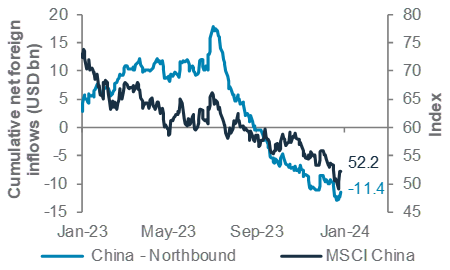
China’s USD bond yield premiums have been largely flat this week, despite the stimulus measures
Asia USD and China USD bond yield premiums

Top client questions (cont’d)
What are your latest three-month currency views?
Major central banks, including the BoJ, the BoC and the ECB, have concluded their first policy meeting of 2024. Their decisions, alongside technical indicators, remain key to the three-month currency outlook.
The BoJ kept its negative interest rate policy unchanged and lowered its inflation forecast. While Governor Ueda said that the policy is unlikely to be tightened until wage growth increases, he suggested a shift in policy was only a matter of time. Japan’s spring wage talks start in March, and any signs of above-inflation wage hikes are likely to enable the BoJ to end its negative rates policy. We see USD/JPY moving lower to 140 over the next three months.
The BoJ was soon followed by the BoC, which kept the policy rate unchanged at 5% for the fourth time in a row. It also signalled another hike was unlikely if economic data evolved as forecast. We expect USD/CAD to consolidate around 1.34 over three months.
The ECB also kept its policy rate unchanged. Markets expect the first rate cut in June. While we await the Fed policy meeting next week (markets expect the first rate cut in May), we expect near-term real interest rate differentials to support EUR/USD and the pair to rise to 1.10 in three months. The USD index (DXY) is likely to be largely rangebound without any rate moves from various central banks. The BoE policy meeting will be closely watched next week as well. We expect it to start rate cuts later than the Fed given stickier UK inflation, leaving real yield differentiations in a narrow range. This supports our rangebound view on GBP/USD. We expect the pair at 1.25 in the next three months. We see USD/CHF weakening marginally to 0.86 over the next three months as a still-hawkish SNB seeks to maintain a strong CHF for now to contain imported inflation.
In Asia Pacific, concerns about sticky wage growth in Australia and New Zealand are likely to result in both the RBA and the RBNZ keeping rates elevated longer than other major central banks. We expect AUD/USD to rise to 0.67 in three months’ time and NZD/USD to rise to 0.62. In China, the PBoC cut banks’ reserve requirement ratio by 50bps effective 5 February, the biggest cut since December 2021, as policymakers extended efforts to shore up the economy. USD/CNY is likely to be largely stable over the next three months at 7.15.
— Iris Yuen, Investment Strategist
Our updated 3-month FX forecasts

Money markets are expecting the RBA to keep rates elevated longer than other central banks
Money market-implied interest rate changes over the next 3 and 6 months
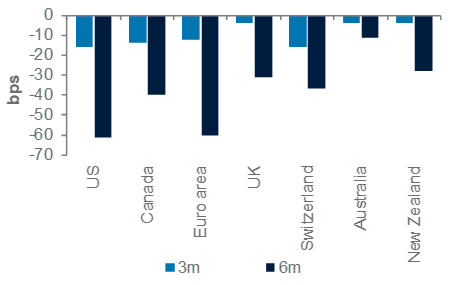
Top client questions (cont’d)
Are fund flows still supporting US equities? Should investors chase US equities higher?
In recent weeks, investors have been increasing their Overweight in US equities, while there has been some trimming in their Overweight in global equities. This indicates that US equities are seeing fund inflows at the expense of other major regions. Depending on the horizon, studies show that allocations to US equities are +1.0 to +1.5 standard deviations above their medium- to long-term averages.
There have been concerns that Fed rate cut expectations have gone “too far, too fast”, resulting in the backing up of US 10-year government bond yields. Moreover, investor positioning has been rising in the more defensive sectors such as staples, Utilities and healthcare. In our view, this warrants caution and builds the case for investors to rebalance by partly trimming exposure to US equities, particularly from in our preferred Growth-heavy communication services and consumer discretionary sectors.
Against this backdrop, we believe it is attractive to either (i) rotate into the healthcare sector, where we are also Overweight in our “barbell approach”, or (ii) add back to US equities if the S&P500 pulls back to key technical support levels of 4,550 and 4,400.
— Daniel Lam, Head, Equity Strategy
Amid stretched investor positioning, investors can consider either adding back at 4,550 and 4,400 technical support levels (for S&P500), or rotating into more defensive sectors such as healthcare
S&P 500 index
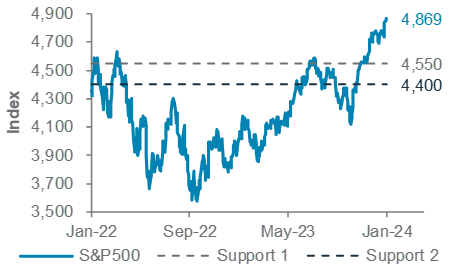
Are tensions on the Red Sea a risk to US inflation?
History shows that most geopolitical events have a temporary impact on markets, raising volatility over the short term but with very limited impact over the long term. South Korea’s KOSPI index is a good example of this, with most Korean peninsula tensions creating largely short-lived volatility for markets. Occasionally, of course, an event can have a more long-lasting impact on markets, such as the start of the Ukraine conflict via the gas price channel.
We would view Red Sea tensions within this framework. The concern is that higher shipping costs feed through to higher US inflation as shipping delays add to costs. For now, we continue to see this more as a risk scenario rather than a central scenario given direct military conflict remains geographically limited. However, a ‘boiling frog’ syndrome, where a conflict continues to spread gradually and create significant supply disruptions, is a risk we would monitor.
For crude oil markets specifically, we expect the geopolitical risk premium to fade under our central scenario. The next technical support for WTI oil is at USD 70/bbl. That said, investors can consider hedging via gold, energy sector equities or through US inflation-indexed government bonds (TIPS). We see 10-year TIPS as inexpensive given it is currently pricing in long-term CPI inflation of around 1.8%, which is lower than the Fed’s target (2.0%).
— Manpreet Gill, Chief Investment Officer, AMEE
— Zhong Liang Han, CFA, Investment Strategist
Shipping costs have spiked on Red Sea tensions
Freight rate from China to the Mediterranean
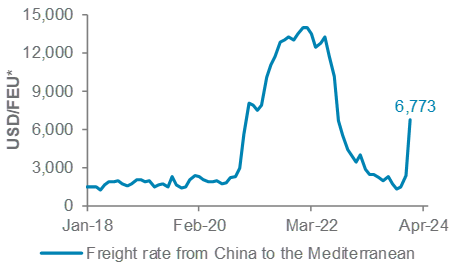
*Forty-foot equivalent unit, which is the size of one container
Market performance summary*
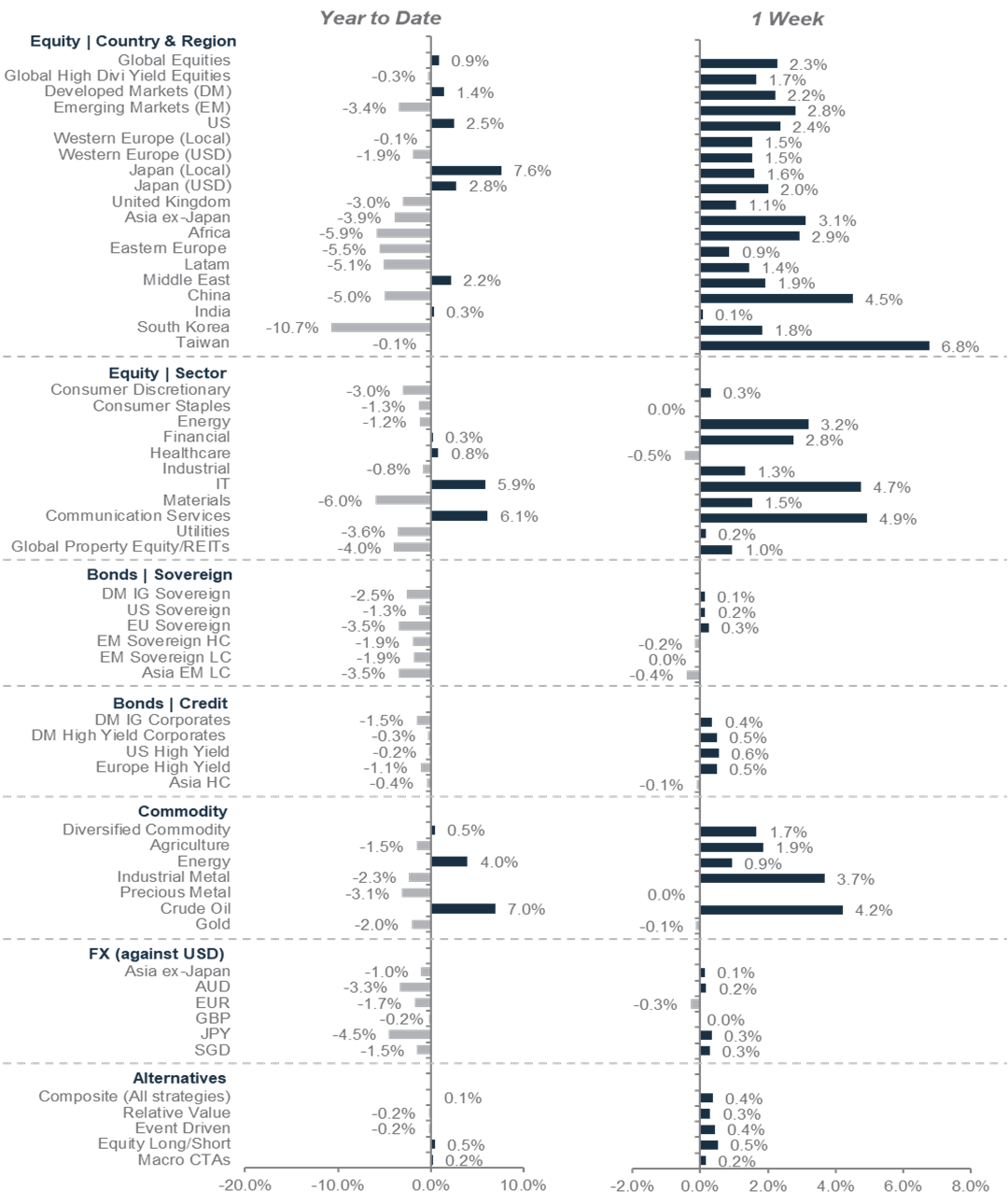
*Performance in USD terms unless otherwise stated, 2024 YTD performance from 31 December 2023 to 25 January 2024; 1-week period: 18 January 2024 to 25 January 2024
Our 12-month asset class views at a glance
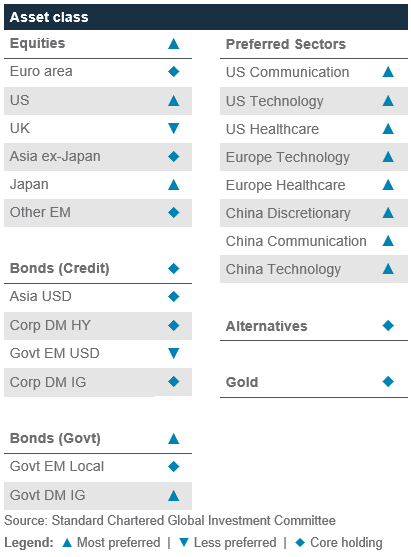
Economic and market calendar

S&P500 index has immediate resistance at 4,912
Technical indicators for key markets as of 25 January close
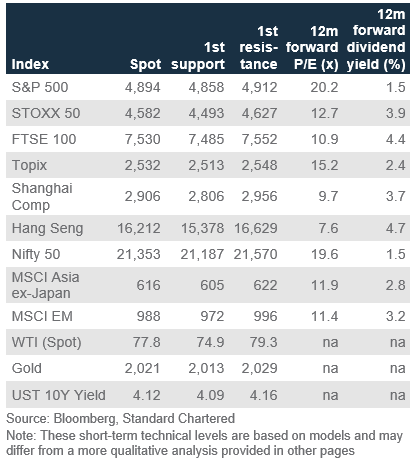
Investor diversity points to a reversal in US equity markets
Our proprietary market diversity indicators as of 25 January
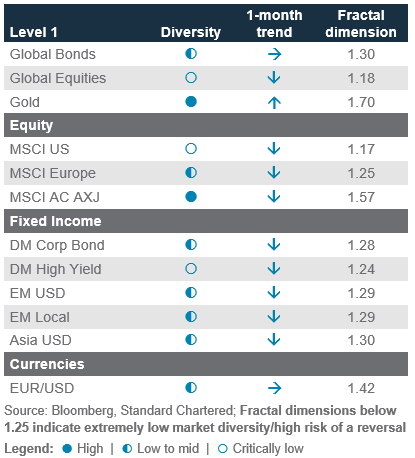

Disclosure
This document is confidential and may also be privileged. If you are not the intended recipient, please destroy all copies and notify the sender immediately. This document is being distributed for general information only and is subject to the relevant disclaimers available at our Standard Chartered website under Regulatory disclosures. It is not and does not constitute research material, independent research, an offer, recommendation or solicitation to enter into any transaction or adopt any hedging, trading or investment strategy, in relation to any securities or other financial instruments. This document is for general evaluation only. It does not take into account the specific investment objectives, financial situation or particular needs of any particular person or class of persons and it has not been prepared for any particular person or class of persons. You should not rely on any contents of this document in making any investment decisions. Before making any investment, you should carefully read the relevant offering documents and seek independent legal, tax and regulatory advice. In particular, we recommend you to seek advice regarding the suitability of the investment product, taking into account your specific investment objectives, financial situation or particular needs, before you make a commitment to purchase the investment product. Opinions, projections and estimates are solely those of SC at the date of this document and subject to change without notice. Past performance is not indicative of future results and no representation or warranty is made regarding future performance. The value of investments, and the income from them, can go down as well as up, and you may not recover the amount of your original investment. You are not certain to make a profit and may lose money. Any forecast contained herein as to likely future movements in rates or prices or likely future events or occurrences constitutes an opinion only and is not indicative of actual future movements in rates or prices or actual future events or occurrences (as the case may be). This document must not be forwarded or otherwise made available to any other person without the express written consent of the Standard Chartered Group (as defined below). Standard Chartered Bank is incorporated in England with limited liability by Royal Charter 1853 Reference Number ZC18. The Principal Office of the Company is situated in England at 1 Basinghall Avenue, London, EC2V 5DD. Standard Chartered Bank is authorised by the Prudential Regulation Authority and regulated by the Financial Conduct Authority and Prudential Regulation Authority. Standard Chartered PLC, the ultimate parent company of Standard Chartered Bank, together with its subsidiaries and affiliates (including each branch or representative office), form the Standard Chartered Group. Standard Chartered Private Bank is the private banking division of Standard Chartered. Private banking activities may be carried out internationally by different legal entities and affiliates within the Standard Chartered Group (each an “SC Group Entity”) according to local regulatory requirements. Not all products and services are provided by all branches, subsidiaries and affiliates within the Standard Chartered Group. Some of the SC Group Entities only act as representatives of Standard Chartered Private Bank and may not be able to offer products and services or offer advice to clients.
Copyright © 2025, Accounting Research & Analytics, LLC d/b/a CFRA (and its affiliates, as applicable). Reproduction of content provided by CFRA in any form is prohibited except with the prior written permission of CFRA. CFRA content is not investment advice and a reference to or observation concerning a security or investment provided in the CFRA SERVICES is not a recommendation to buy, sell or hold such investment or security or make any other investment decisions. The CFRA content contains opinions of CFRA based upon publicly-available information that CFRA believes to be reliable and the opinions are subject to change without notice. This analysis has not been submitted to, nor received approval from, the United States Securities and Exchange Commission or any other regulatory body. While CFRA exercised due care in compiling this analysis, CFRA, ITS THIRD-PARTY SUPPLIERS, AND ALL RELATED ENTITIES SPECIFICALLY DISCLAIM ALL WARRANTIES, EXPRESS OR IMPLIED, INCLUDING, BUT NOT LIMITED TO, ANY WARRANTIES OF MERCHANTABILITY OR FITNESS FOR A PARTICULAR PURPOSE OR USE, to the full extent permitted by law, regarding the accuracy, completeness, or usefulness of this information and assumes no liability with respect to the consequences of relying on this information for investment or other purposes. No content provided by CFRA (including ratings, credit-related analyses and data, valuations, model, software or other application or output therefrom) or any part thereof may be modified, reverse engineered, reproduced or distributed in any form by any means, or stored in a database or retrieval system, without the prior written permission of CFRA, and such content shall not be used for any unlawful or unauthorized purposes. CFRA and any third-party providers, as well as their directors, officers, shareholders, employees or agents do not guarantee the accuracy, completeness, timeliness or availability of such content. In no event shall CFRA, its affiliates, or their third-party suppliers be liable for any direct, indirect, special, or consequential damages, costs, expenses, legal fees, or losses (including lost income or lost profit and opportunity costs) in connection with a subscriber’s, subscriber’s customer’s, or other’s use of CFRA’s content.
Market Abuse Regulation (MAR) Disclaimer
Banking activities may be carried out internationally by different branches, subsidiaries and affiliates within the Standard Chartered Group according to local regulatory requirements. Opinions may contain outright “buy”, “sell”, “hold” or other opinions. The time horizon of this opinion is dependent on prevailing market conditions and there is no planned frequency for updates to the opinion. This opinion is not independent of Standard Chartered Group’s trading strategies or positions. Standard Chartered Group and/or its affiliates or its respective officers, directors, employee benefit programmes or employees, including persons involved in the preparation or issuance of this document may at any time, to the extent permitted by applicable law and/or regulation, be long or short any securities or financial instruments referred to in this document or have material interest in any such securities or related investments. Therefore, it is possible, and you should assume, that Standard Chartered Group has a material interest in one or more of the financial instruments mentioned herein. Please refer to our Standard Chartered website under Regulatory disclosures for more detailed disclosures, including past opinions/ recommendations in the last 12 months and conflict of interests, as well as disclaimers. A covering strategist may have a financial interest in the debt or equity securities of this company/issuer. This document must not be forwarded or otherwise made available to any other person without the express written consent of Standard Chartered Group.
Sustainable Investments
Any ESG data used or referred to has been provided by Morningstar, Sustainalytics, MSCI or Bloomberg. Refer to 1) Morningstar website under Sustainable Investing, 2) Sustainalytics website under ESG Risk Ratings, 3) MCSI website under ESG Business Involvement Screening Research and 4) Bloomberg green, social & sustainability bonds guide for more information. The ESG data is as at the date of publication based on data provided, is for informational purpose only and is not warranted to be complete, timely, accurate or suitable for a particular purpose, and it may be subject to change. Sustainable Investments (SI): This refers to funds that have been classified as ‘Sustainable Investments’ by Morningstar. SI funds have explicitly stated in their prospectus and regulatory filings that they either incorporate ESG factors into the investment process or have a thematic focus on the environment, gender diversity, low carbon, renewable energy, water or community development. For equity, it refers to shares/stocks issued by companies with Sustainalytics ESG Risk Rating of Low/Negligible. For bonds, it refers to debt instruments issued by issuers with Sustainalytics ESG Risk Rating of Low/Negligible, and/or those being certified green, social, sustainable bonds by Bloomberg. For structured products, it refers to products that are issued by any issuer who has a Sustainable Finance framework that aligns with Standard Chartered’s Green and Sustainable Product Framework, with underlying assets that are part of the Sustainable Investment universe or separately approved by Standard Chartered’s Sustainable Finance Governance Committee. Sustainalytics ESG risk ratings shown are factual and are not an indicator that the product is classified or marketed as “green”, “sustainable” or similar under any particular classification system or framework.
Country/Market Specific Disclosures
Botswana: This document is being distributed in Botswana by, and is attributable to, Standard Chartered Bank Botswana Limited which is a financial institution licensed under the Section 6 of the Banking Act CAP 46.04 and is listed in the Botswana Stock Exchange. Brunei Darussalam: This document is being distributed in Brunei Darussalam by, and is attributable to, Standard Chartered Bank (Brunei Branch) | Registration Number RFC/61 and Standard Chartered Securities (B) Sdn Bhd | Registration Number RC20001003. Standard Chartered Bank is incorporated in England with limited liability by Royal Charter 1853 Reference Number ZC18. Standard Chartered Securities (B) Sdn Bhd is a limited liability company registered with the Registry of Companies with Registration Number RC20001003 and licensed by Brunei Darussalam Central Bank as a Capital Markets Service License Holder with License Number BDCB/R/CMU/S3-CL and it is authorised to conduct Islamic investment business through an Islamic window. China Mainland: This document is being distributed in China by, and is attributable to, Standard Chartered Bank (China) Limited which is mainly regulated by National Financial Regulatory Administration (NFRA), State Administration of Foreign Exchange (SAFE), and People’s Bank of China (PBOC). Hong Kong: In Hong Kong, this document, except for any portion advising on or facilitating any decision on futures contracts trading, is distributed by Standard Chartered Bank (Hong Kong) Limited (“SCBHK”), a subsidiary of Standard Chartered PLC. SCBHK has its registered address at 32/F, Standard Chartered Bank Building, 4-4A Des Voeux Road Central, Hong Kong and is regulated by the Hong Kong Monetary Authority and registered with the Securities and Futures Commission (“SFC”) to carry on Type 1 (dealing in securities), Type 4 (advising on securities), Type 6 (advising on corporate finance) and Type 9 (asset management) regulated activity under the Securities and Futures Ordinance (Cap. 571) (“SFO”) (CE No. AJI614). The contents of this document have not been reviewed by any regulatory authority in Hong Kong and you are advised to exercise caution in relation to any offer set out herein. If you are in doubt about any of the contents of this document, you should obtain independent professional advice. Any product named herein may not be offered or sold in Hong Kong by means of any document at any time other than to “professional investors” as defined in the SFO and any rules made under that ordinance. In addition, this document may not be issued or possessed for the purposes of issue, whether in Hong Kong or elsewhere, and any interests may not be disposed of, to any person unless such person is outside Hong Kong or is a “professional investor” as defined in the SFO and any rules made under that ordinance, or as otherwise may be permitted by that ordinance. In Hong Kong, Standard Chartered Private Bank is the private banking division of SCBHK, a subsidiary of Standard Chartered PLC. Ghana: Standard Chartered Bank Ghana Limited accepts no liability and will not be liable for any loss or damage arising directly or indirectly (including special, incidental or consequential loss or damage) from your use of these documents. Past performance is not indicative of future results and no representation or warranty is made regarding future performance. You should seek advice from a financial adviser on the suitability of an investment for you, taking into account these factors before making a commitment to invest in an investment. To unsubscribe from receiving further updates, please send an email to feedback.ghana@sc.com. Please do not reply to this email. Call our Priority Banking on 0302610750 for any questions or service queries. You are advised not to send any confidential and/or important information to Standard Chartered via e-mail, as Standard Chartered makes no representations or warranties as to the security or accuracy of any information transmitted via e-mail. Standard Chartered shall not be responsible for any loss or damage suffered by you arising from your decision to use e-mail to communicate with the Bank. India: This document is being distributed in India by Standard Chartered in its capacity as a distributor of mutual funds and referrer of any other third party financial products. Standard Chartered does not offer any ‘Investment Advice’ as defined in the Securities and Exchange Board of India (Investment Advisers) Regulations, 2013 or otherwise. Services/products related securities business offered by Standard Charted are not intended for any person, who is a resident of any jurisdiction, the laws of which imposes prohibition on soliciting the securities business in that jurisdiction without going through the registration requirements and/or prohibit the use of any information contained in this document. Indonesia: This document is being distributed in Indonesia by Standard Chartered Bank, Indonesia branch, which is a financial institution licensed, registered and supervised by Otoritas Jasa Keuangan (Financial Service Authority). Jersey: In Jersey, Standard Chartered Private Bank is the Registered Business Name of the Jersey Branch of Standard Chartered Bank. The Jersey Branch of Standard Chartered Bank is regulated by the Jersey Financial Services Commission. Copies of the latest audited accounts of Standard Chartered Bank are available from its principal place of business in Jersey: PO Box 80, 15 Castle Street, St Helier, Jersey JE4 8PT. Standard Chartered Bank is incorporated in England with limited liability by Royal Charter in 1853 Reference Number ZC 18. The Principal Office of the Company is situated in England at 1 Basinghall Avenue, London, EC2V 5DD. Standard Chartered Bank is authorised by the Prudential Regulation Authority and regulated by the Financial Conduct Authority and Prudential Regulation Authority. The Jersey Branch of Standard Chartered Bank is also an authorised financial services provider under license number 44946 issued by the Financial Sector Conduct Authority of the Republic of South Africa. Jersey is not part of the United Kingdom and all business transacted with Standard Chartered Bank, Jersey Branch and other SC Group Entity outside of the United Kingdom, are not subject to some or any of the investor protection and compensation schemes available under United Kingdom law. Kenya: This document is being distributed in Kenya by and is attributable to Standard Chartered Bank Kenya Limited. Investment Products and Services are distributed by Standard Chartered Investment Services Limited, a wholly owned subsidiary of Standard Chartered Bank Kenya Limited that is licensed by the Capital Markets Authority in Kenya, as a Fund Manager. Standard Chartered Bank Kenya Limited is regulated by the Central Bank of Kenya. Malaysia: This document is being distributed in Malaysia by Standard Chartered Bank Malaysia Berhad (“SCBMB”). Recipients in Malaysia should contact SCBMB in relation to any matters arising from, or in connection with, this document. This document has not been reviewed by the Securities Commission Malaysia. The product lodgement, registration, submission or approval by the Securities Commission of Malaysia does not amount to nor indicate recommendation or endorsement of the product, service or promotional activity. Investment products are not deposits and are not obligations of, not guaranteed by, and not protected by SCBMB or any of the affiliates or subsidiaries, or by Perbadanan Insurans Deposit Malaysia, any government or insurance agency. Investment products are subject to investment risks, including the possible loss of the principal amount invested. SCBMB expressly disclaim any liability and responsibility for any loss arising directly or indirectly (including special, incidental or consequential loss or damage) arising from the financial losses of the Investment Products due to market condition. Nigeria: This document is being distributed in Nigeria by Standard Chartered Bank Nigeria Limited (SCB Nigeria), a bank duly licensed and regulated by the Central Bank of Nigeria. SCB Nigeria accepts no liability for any loss or damage arising directly or indirectly (including special, incidental or consequential loss or damage) from your use of these documents. You should seek advice from a financial adviser on the suitability of an investment for you, taking into account these factors before making a commitment to invest in an investment. To unsubscribe from receiving further updates, please send an email to clientcare.ng@sc.com requesting to be removed from our mailing list. Please do not reply to this email. Call our Priority Banking on 02 012772514 for any questions or service queries. Standard Chartered shall not be responsible for any loss or damage arising from your decision to send confidential and/or important information to Standard Chartered via e-mail, as Standard Chartered makes no representations or warranties as to the security or accuracy of any information transmitted via e-mail. Pakistan: This document is being distributed in Pakistan by, and attributable to Standard Chartered Bank (Pakistan) Limited having its registered office at PO Box 5556, I.I Chundrigar Road Karachi, which is a banking company registered with State Bank of Pakistan under Banking Companies Ordinance 1962 and is also having licensed issued by Securities & Exchange Commission of Pakistan for Security Advisors. Standard Chartered Bank (Pakistan) Limited acts as a distributor of mutual funds and referrer of other third-party financial products. Singapore: This document is being distributed in Singapore by, and is attributable to, Standard Chartered Bank (Singapore) Limited (Registration No. 201224747C/ GST Group Registration No. MR-8500053-0, “SCBSL”). Recipients in Singapore should contact SCBSL in relation to any matters arising from, or in connection with, this document. SCBSL is an indirect wholly owned subsidiary of Standard Chartered Bank and is licensed to conduct banking business in Singapore under the Singapore Banking Act, 1970. Standard Chartered Private Bank is the private banking division of SCBSL. IN RELATION TO ANY SECURITY OR SECURITIES-BASED DERIVATIVES CONTRACT REFERRED TO IN THIS DOCUMENT, THIS DOCUMENT, TOGETHER WITH THE ISSUER DOCUMENTATION, SHALL BE DEEMED AN INFORMATION MEMORANDUM (AS DEFINED IN SECTION 275 OF THE SECURITIES AND FUTURES ACT, 2001 (“SFA”)). THIS DOCUMENT IS INTENDED FOR DISTRIBUTION TO ACCREDITED INVESTORS, AS DEFINED IN SECTION 4A(1)(a) OF THE SFA, OR ON THE BASIS THAT THE SECURITY OR SECURITIES-BASED DERIVATIVES CONTRACT MAY ONLY BE ACQUIRED AT A CONSIDERATION OF NOT LESS THAN S$200,000 (OR ITS EQUIVALENT IN A FOREIGN CURRENCY) FOR EACH TRANSACTION. Further, in relation to any security or securities-based derivatives contract, neither this document nor the Issuer Documentation has been registered as a prospectus with the Monetary Authority of Singapore under the SFA. Accordingly, this document and any other document or material in connection with the offer or sale, or invitation for subscription or purchase, of the product may not be circulated or distributed, nor may the product be offered or sold, or be made the subject of an invitation for subscription or purchase, whether directly or indirectly, to persons other than a relevant person pursuant to section 275(1) of the SFA, or any person pursuant to section 275(1A) of the SFA, and in accordance with the conditions specified in section 275 of the SFA, or pursuant to, and in accordance with the conditions of, any other applicable provision of the SFA. In relation to any collective investment schemes referred to in this document, this document is for general information purposes only and is not an offering document or prospectus (as defined in the SFA). This document is not, nor is it intended to be (i) an offer or solicitation of an offer to buy or sell any capital markets product; or (ii) an advertisement of an offer or intended offer of any capital markets product. Deposit Insurance Scheme: Singapore dollar deposits of non-bank depositors are insured by the Singapore Deposit Insurance Corporation, for up to S$100,000 in aggregate per depositor per Scheme member by law. Foreign currency deposits, dual currency investments, structured deposits and other investment products are not insured. This advertisement has not been reviewed by the Monetary Authority of Singapore. Taiwan: SC Group Entity or Standard Chartered Bank (Taiwan) Limited (“SCB (Taiwan)”) may be involved in the financial instruments contained herein or other related financial instruments. The author of this document may have discussed the information contained herein with other employees or agents of SC or SCB (Taiwan). The author and the above-mentioned employees of SC or SCB (Taiwan) may have taken related actions in respect of the information involved (including communication with customers of SC or SCB (Taiwan) as to the information contained herein). The opinions contained in this document may change, or differ from the opinions of employees of SC or SCB (Taiwan). SC and SCB (Taiwan) will not provide any notice of any changes to or differences between the above-mentioned opinions. This document may cover companies with which SC or SCB (Taiwan) seeks to do business at times and issuers of financial instruments. Therefore, investors should understand that the information contained herein may serve as specific purposes as a result of conflict of interests of SC or SCB (Taiwan). SC, SCB (Taiwan), the employees (including those who have discussions with the author) or customers of SC or SCB (Taiwan) may have an interest in the products, related financial instruments or related derivative financial products contained herein; invest in those products at various prices and on different market conditions; have different or conflicting interests in those products. The potential impacts include market makers’ related activities, such as dealing, investment, acting as agents, or performing financial or consulting services in relation to any of the products referred to in this document. UAE: DIFC – Standard Chartered Bank is incorporated in England with limited liability by Royal Charter 1853 Reference Number ZC18.The Principal Office of the Company is situated in England at 1 Basinghall Avenue, London, EC2V 5DD. Standard Chartered Bank is authorised by the Prudential Regulation Authority and regulated by the Financial Conduct Authority and Prudential Regulation Authority. Standard Chartered Bank, Dubai International Financial Centre having its offices at Dubai International Financial Centre, Building 1, Gate Precinct, P.O. Box 999, Dubai, UAE is a branch of Standard Chartered Bank and is regulated by the Dubai Financial Services Authority (“DFSA”). This document is intended for use only by Professional Clients and is not directed at Retail Clients as defined by the DFSA Rulebook. In the DIFC we are authorised to provide financial services only to clients who qualify as Professional Clients and Market Counterparties and not to Retail Clients. As a Professional Client you will not be given the higher retail client protection and compensation rights and if you use your right to be classified as a Retail Client we will be unable to provide financial services and products to you as we do not hold the required license to undertake such activities. For Islamic transactions, we are acting under the supervision of our Shariah Supervisory Committee. Relevant information on our Shariah Supervisory Committee is currently available on the Standard Chartered Bank website in the Islamic banking section. For residents of the UAE – Standard Chartered Bank UAE does not provide financial analysis or consultation services in or into the UAE within the meaning of UAE Securities and Commodities Authority Decision No. 48/r of 2008 concerning financial consultation and financial analysis. Uganda: Our Investment products and services are distributed by Standard Chartered Bank Uganda Limited, which is licensed by the Capital Markets Authority as an investment adviser. United Kingdom: In the UK, Standard Chartered Bank is authorised by the Prudential Regulation Authority and regulated by the Financial Conduct Authority and Prudential Regulation Authority. This communication has been approved by Standard Chartered Bank for the purposes of Section 21 (2) (b) of the United Kingdom’s Financial Services and Markets Act 2000 (“FSMA”) as amended in 2010 and 2012 only. Standard Chartered Bank (trading as Standard Chartered Private Bank) is also an authorised financial services provider (license number 45747) in terms of the South African Financial Advisory and Intermediary Services Act, 2002. The Materials have not been prepared in accordance with UK legal requirements designed to promote the independence of investment research, and that it is not subject to any prohibition on dealing ahead of the dissemination of investment research. Vietnam: This document is being distributed in Vietnam by, and is attributable to, Standard Chartered Bank (Vietnam) Limited which is mainly regulated by State Bank of Vietnam (SBV). Recipients in Vietnam should contact Standard Chartered Bank (Vietnam) Limited for any queries regarding any content of this document. Zambia: This document is distributed by Standard Chartered Bank Zambia Plc, a company incorporated in Zambia and registered as a commercial bank and licensed by the Bank of Zambia under the Banking and Financial Services Act Chapter 387 of the Laws of Zambia.
